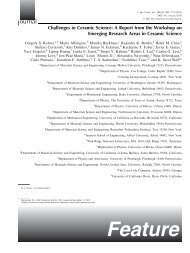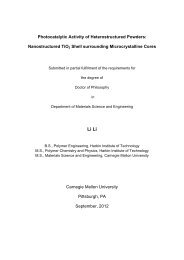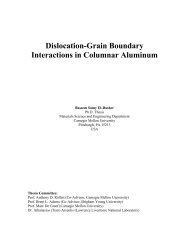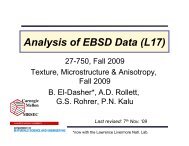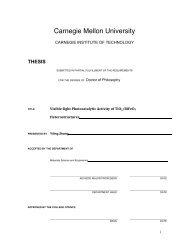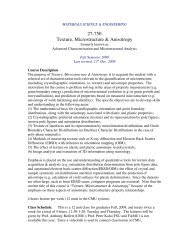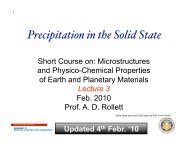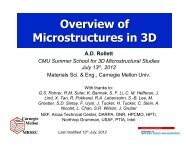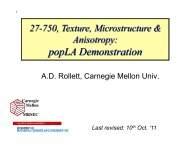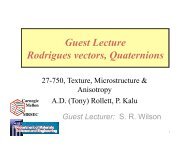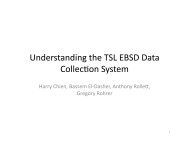¶ 3. Mathematical Representation of Crystal Orientation, Misorientation
¶ 3. Mathematical Representation of Crystal Orientation, Misorientation
¶ 3. Mathematical Representation of Crystal Orientation, Misorientation
Create successful ePaper yourself
Turn your PDF publications into a flip-book with our unique Google optimized e-Paper software.
ICOTOM-8, Santa Fe, TMS, Warrendale, PA.] to address this issue. The first and third<br />
angles can be replaced by the following, where ν is equivalent to a parameter β used<br />
previously by Williams.<br />
ν = (Ψ-φ)/2<br />
µ = (Ψ+φ)/2 (<strong>3.</strong>C.2.3)<br />
These are related to the oblique section parameters <strong>of</strong> Bunge (φ + ,φ - ) and Helming (σ,δ) by<br />
φ + = σ = ν+π/2, and φ - = δ+π/2 = µ.<br />
Note that when two rotations are expressed in the form <strong>of</strong> Euler angles, there is no simple<br />
method for combining them. It is usually sensible to convert them to matrix form before<br />
performing manipulations on them. The action <strong>of</strong> symmetry operators on orientations<br />
can, however, be expressed in reasonably simple terms.<br />
<strong>3.</strong>C.3 Conversions<br />
To convert from Miller index description to Euler angles, one may use these formulae.<br />
ϕ 1 = sin −1<br />
Φ = cos −1 l<br />
h 2 + k 2 + l 2<br />
⎛<br />
⎜<br />
⎝<br />
⎞<br />
⎟<br />
⎠<br />
ϕ2 = cos −1 k<br />
h 2 + k 2<br />
⎛<br />
⎜<br />
⎝<br />
⎞<br />
⎟<br />
⎠<br />
w<br />
u 2 + v 2 + w 2<br />
h 2 + k 2 + l 2<br />
h 2 + k 2<br />
⎛<br />
⎜<br />
⎝<br />
⎞<br />
⎟<br />
⎠<br />
(<strong>3.</strong>C.<strong>3.</strong>1)<br />
A limitation <strong>of</strong> these formulae from a numerical perspective is the range <strong>of</strong> inverse<br />
trigonometric functions. The only such function that can cover the range 0-2π is the<br />
inverse tangent € function with two arguments, generally written as ATAN2 (lower case<br />
for C programs). Considerable care with this inverse trigonometric function is required<br />
because in some s<strong>of</strong>tware packages such as Excel, the two arguments are ordered as<br />
{x,y}, whereas in C and Fortran, they are ordered in the opposite fashion as {y,x}. Also,<br />
if both arguments approach zero, the result is undefined and the function will return an<br />
error. This means that the programmer has to detect this condition and take special<br />
measures, which can easily happen for orientations close to the reference position (cube<br />
component). Therefore it is better to write the orientation (rotation) matrix in terms <strong>of</strong><br />
the Miller indices, and then convert from matrix to Euler angles, as given here:<br />
€<br />
( )<br />
Φ = cos −1 a33 ϕ 2 = tan −1⎛ ( a13 ⎜<br />
⎝<br />
sin Φ)<br />
( a23<br />
⎞<br />
sin Φ<br />
⎟<br />
) ⎠<br />
ϕ1 = tan −1⎛ ( a31 sin Φ)<br />
⎜<br />
⎝ ( −a32<br />
⎞<br />
sin Φ<br />
⎟<br />
) ⎠<br />
(<strong>3.</strong>C.<strong>3.</strong>2)<br />
8/27/09 12



